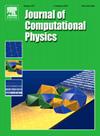Discontinuous Galerkin simulation of sliding geometries using a point-to-point interpolation technique
IF 3.8
2区 物理与天体物理
Q2 COMPUTER SCIENCE, INTERDISCIPLINARY APPLICATIONS
引用次数: 0
Abstract
The high-fidelity modelling of geometry which rotates or translates is a key requirement in fluid mechanics applications, enabling the simulation of parts such as rotors and pressure cascades. These prescribed motions can be imposed through the movement of the mesh representing the problem, where an interface is constructed across the nonconformal interface, bridging the static and moving regions of the mesh. The challenge is maintaining the solution accuracy across this interface, which will involve nonconformal elements on its sides due to the sliding meshes, while having a robust and efficient approach for complex interfaces. This work uses a point-to-point interpolation technique for such sliding interfaces, leveraging the high-order discontinuous Galerkin method for discretising governing equations and the Arbitrary Lagrangian-Eulerian (ALE) method in handling sliding meshes. With its straightforward and efficient approach, the point-to-point interpolation method has an advantage over other approaches in dealing with the complex interface while having excellent accuracy in preserving the discrete geometric conservation law (DGCL), as demonstrated in this study. Linear and non-linear hyperbolic systems, including the compressible Euler and Navier-Stokes equations, are considered with detailed analysis demonstrating the point-to-point method's accuracy using several examples and under various settings in the context of high-order methods for flow problems.
求助全文
约1分钟内获得全文
求助全文
来源期刊

Journal of Computational Physics
物理-计算机:跨学科应用
CiteScore
7.60
自引率
14.60%
发文量
763
审稿时长
5.8 months
期刊介绍:
Journal of Computational Physics thoroughly treats the computational aspects of physical problems, presenting techniques for the numerical solution of mathematical equations arising in all areas of physics. The journal seeks to emphasize methods that cross disciplinary boundaries.
The Journal of Computational Physics also publishes short notes of 4 pages or less (including figures, tables, and references but excluding title pages). Letters to the Editor commenting on articles already published in this Journal will also be considered. Neither notes nor letters should have an abstract.
 求助内容:
求助内容: 应助结果提醒方式:
应助结果提醒方式:


